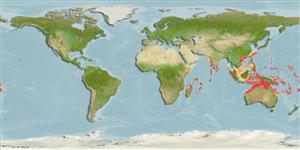Environment: milieu / climate zone / depth range / distribution range
экология
морской ассоциированный с рифами; пределы глубины 1 - 200 m (Ref. 9710). Tropical; 29°N - 24°S, 39°E - 175°W (Ref. 5222)
Indo-West Pacific: insular species ranging from East Africa (excluding the Red Sea and Persian Gulf) to the Gilbert Islands and Samoa, north to the Ryukyu Islands.
Size / Вес / Возраст
Maturity: Lm ? range ? - ? cm
Max length : 53.0 cm TL самец/пол неопределен; (Ref. 90102)
колючие лучи спинного плавника (общее число) : 11; членистые (мягкие) лучи спинного плавника (общее число) : 16 - 17; колючие лучи анального плавника: 3; членистые (мягкие) лучи анального плавника: 8. Have a large spots on the soft-rayed portions of the fins and a fine pattern of small close-set spots on the body and spinous portions of the fins (Ref. 37816); further characterized by having ctenoid scales on body except cycloid anteriorly above lateral line, thorax and abdomen; body with auxiliary scales; greatest depth of body 2.8-3.2 in SL; rounded caudal fin; pelvic fins, 1.7-2.1 in head length (Ref. 90102); head length 2.4-2.6 times in SL; convex interorbital, slightly concave dorsal head profile at eyes; subangular preopercle, shallow notch just above the angle and the serrae at the angle enlarged in juveniles; straight upper edge of operculum; diameter of posterior nostrils about twice that of anterior nostril; maxilla reaches vertical at rear edge of eye; 2-4 rows of teeth on midlateral part of lower jaw; pyloric caeca 30 (Ref. 89707).
Found in a variety of habitats. Solitary (Ref 90102). Juveniles (8-21 cm SL) have been taken from mud bottoms, seagrass beds, mangrove swamps, and from coral reefs in depths of 1 to 16 m; adults in coral reefs at depths of 18 to 180 m (Ref. 89707). Stomach contents reported to include juvenile clappid crab, a stomatopod, and a gastropod (Ref. 6448).
Life cycle and mating behavior
Maturities | размножение | Spawnings | Egg(s) | Fecundities | личинки
Heemstra, P.C. and J.E. Randall, 1993. FAO Species Catalogue. Vol. 16. Groupers of the world (family Serranidae, subfamily Epinephelinae). An annotated and illustrated catalogue of the grouper, rockcod, hind, coral grouper and lyretail species known to date. Rome: FAO. FAO Fish. Synop. 125(16):382 p. (Ref. 5222)
Статус Красного Списка МСОП (Ref. 130435)
Угроза для людей
Harmless
Использование человеком
рыболовство: не имеет хозяйственного значения
дополнительная информация
инструменты
Специальные отчеты
Скачать в формате XML
ресурсы в Интернет
Estimates based on models
Preferred temperature (Ref.
123201): 21.8 - 28.2, mean 26.2 °C (based on 240 cells).
Phylogenetic diversity index (Ref.
82804): PD
50 = 0.5000 [Uniqueness, from 0.5 = low to 2.0 = high].
Bayesian length-weight: a=0.01175 (0.00571 - 0.02419), b=3.04 (2.88 - 3.20), in cm total length, based on LWR estimates for this Genus-body shape (Ref.
93245).
Trophic level (Ref.
69278): 3.8 ±0.62 se; based on food items.
устойчивость к внешним воздействиям (Ref.
120179): средний (среднего размера), минимальное время удвоения популяции 1.4-4.4 года (Preliminary K or Fecundity.).
Fishing Vulnerability (Ref.
59153): Moderate vulnerability (41 of 100).
